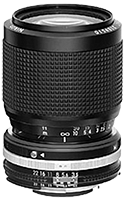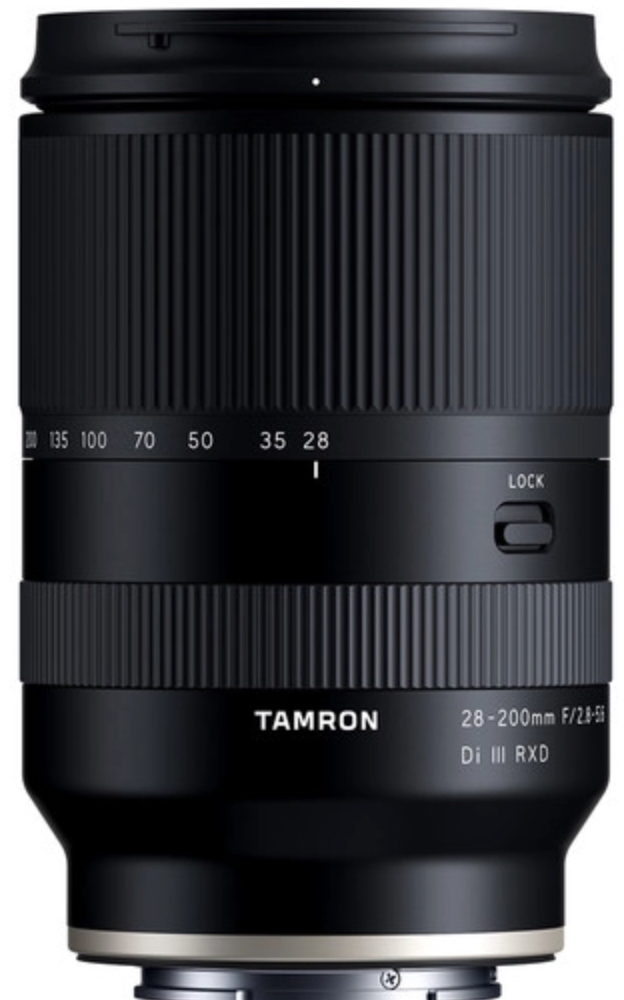 The Tamron 28-200mm f/2.8-5.6 Di III RXD is a "super-zoom" lens
for Sony full-frame and crop-sensor cameras. It provides a 42-300mm equivalent focal length on APS-C
crop-sensor cameras. The auto-focus is fast and silent and its manual zoom ring lets you smoothly select any
focal length. It has a zoom lock ring but no other "bells and whistles". Comparatively small and light, it
weighs only 575 grams and is only 117mm long.
The Tamron 28-200mm f/2.8-5.6 Di III RXD is a "super-zoom" lens
for Sony full-frame and crop-sensor cameras. It provides a 42-300mm equivalent focal length on APS-C
crop-sensor cameras. The auto-focus is fast and silent and its manual zoom ring lets you smoothly select any
focal length. It has a zoom lock ring but no other "bells and whistles". Comparatively small and light, it
weighs only 575 grams and is only 117mm long.
This lens is sharp all the way out to the corners on full-frame (not just APS-C). Although it does not have internal stabilization, it integrates with Sony's 5-axis in-body image stabilization.
This $729 lens replaces both the Sony 24-70 and 70-200mm lenses. While they have OSS (Optical Steady Shot) which further improves stabilization, they cost $2300 and $2800 respectively - and each of them is larger and heavier than the Tamron. Therefore you might be happier to carry one small lightweight lens... and keep the money.
This lens is a very portable choice for travel and family photography, but I'm now using it for everything except macro shooting. You can see some sample images here.
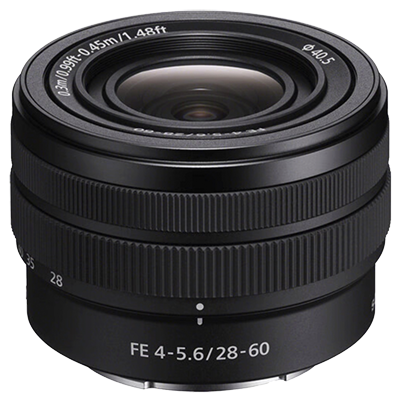 The
Sony 28-60mm FE is a kit lens for Sony full-frame and crop-sensor
cameras. It provides a 42-90mm equivalent focal length on APS-C cameras. Its auto-focus is fast and silent
and its manual zoom ring lets you smoothly select any focal length.
The
Sony 28-60mm FE is a kit lens for Sony full-frame and crop-sensor
cameras. It provides a 42-90mm equivalent focal length on APS-C cameras. Its auto-focus is fast and silent
and its manual zoom ring lets you smoothly select any focal length.
This lens is very sharp wide open, all the way out to the corners on full-frame (not just APS-C). In my testing, at 55mm it is just as sharp as my 55mm Micro Nikkor f/2.8 and has excellent blur rendition. There is some barrel distortion at the widest focal length. I purchased my copy used from KEH.
This lens is a HIGHLY portable choice for travel and family photography. I use this lens when I want the smallest kit possible. Very small and light due to its retractable design, it weighs only 167 grams and is only 67mm long: shorter in total length than the filter size of many other lenses. You can see some sample images here.
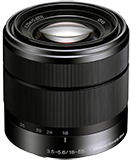 The Sony
E 18-55mm f/3.5-5.6 OSS was the original kit lens for Sony E-mount (crop-sensor) cameras. It
provides a 27-82.5mm equivalent focal length. It is very small and light, yet has optical stabilization and
auto-focus which integrates with Sony face/eye recognition. This lens lets you shoot down to 9.7″, close
enough for photos of flowers and other small objects. Its manual zoom ring lets you smoothly select any focal length.
The Sony
E 18-55mm f/3.5-5.6 OSS was the original kit lens for Sony E-mount (crop-sensor) cameras. It
provides a 27-82.5mm equivalent focal length. It is very small and light, yet has optical stabilization and
auto-focus which integrates with Sony face/eye recognition. This lens lets you shoot down to 9.7″, close
enough for photos of flowers and other small objects. Its manual zoom ring lets you smoothly select any focal length.
Like many zoom designs, this lens is very sharp in the center and should be shot at f/8 for best corner resolution. Zoom lenses are rarely as sharp as the many prime lenses they replace, but kit lenses like this are great when we consider their portability and affordability.
If you have one of the Sony APS-C cameras - or shoot a full-frame Sony camera on it's APS-C setting - it's a highly portable choice for travel and family photography. I used it for all these photos of Paris in 2012. Mounted on an NEX-7, the entire kit easily fit into the pocket of my coat. It weighs only 194 grams and is only 60mm long: shorter in total length than the filter size of many other lenses.
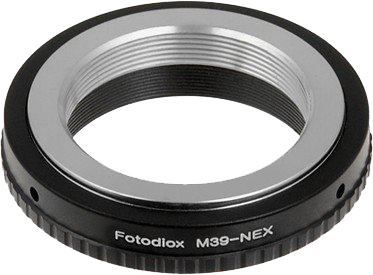 Mirrorless cameras have a very small flange-to-focus
distance, allowing us to adapt a wide variety of 3rd party lenses such as Leica, Nikon, Canon, Pentax,
Voigtlander, etc. To shoot manual lenses, a simple affordable adapter is all that we need. I was
disappointed with a no-name bargain adapter (it developed a light leak which resulted in flare), but
have
had good experience with Fotodiox Sony E-Mount adapters.
Mirrorless cameras have a very small flange-to-focus
distance, allowing us to adapt a wide variety of 3rd party lenses such as Leica, Nikon, Canon, Pentax,
Voigtlander, etc. To shoot manual lenses, a simple affordable adapter is all that we need. I was
disappointed with a no-name bargain adapter (it developed a light leak which resulted in flare), but
have
had good experience with Fotodiox Sony E-Mount adapters.
For fine art subjects (landscape, still-life, portraits), older lenses are often an excellent choice. Many perform just as well as the newest ones, the only difference being that they are manual focus and have no built-in stabilization. Available in the used market, they are affordably priced.
As you can see from my list of lenses, I like vintage Nikkor designs. Some give very neutral blur rendition. Others give a slightly luminous blur rendition, which according to this article by Christopher Perez, can be attributed to "under-corrected spherical aberrations behind the point of focus".
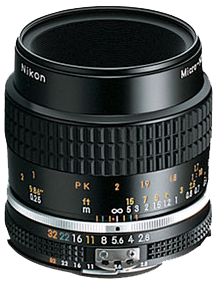 There are countless lenses available in the normal focal length but for its combination of image
quality,
flexibility and low price I chose the
55mm f/2.8 AIS Micro Nikkor from 1979. You can buy this lens
used on eBay or from KEH
but after decades it is still available for purchase
new because it's
a fine performer even by modern standards.
There are countless lenses available in the normal focal length but for its combination of image
quality,
flexibility and low price I chose the
55mm f/2.8 AIS Micro Nikkor from 1979. You can buy this lens
used on eBay or from KEH
but after decades it is still available for purchase
new because it's
a fine performer even by modern standards.
It focuses down to 1:2 but is very sharp at all distances due to what Nikon calls Close Range Correction: a floating internal element. At its closest magnification of 0.5X, it's close to the top of the heap on the coinimaging.com Hall of Fame
With this model, no lens shade is required because the optics are recessed within the barrel. Because this lens does not open wide it is light and portable, taking 52mm filters like many other Nikon designs. I love macro lenses: they are usually free from chromatic aberration and geometric distortion. Many standard lenses are sharp but if you like to shoot at close distance without needing an adapter and you appreciate not needing a lens hood or corrections in post-processing, this is a fine choice.
This lens has very neutral blur rendition.
For a collection of images made with the 55m f/2.8 Micro Nikkor, click here.
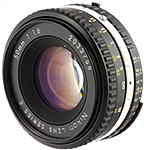 For a very portable high-quality lens, consider the Nikkor
50mm f/1.8 Series E. This lens is only 33mm long, weighs only
155 grams and takes standard 52mm filters. Mounted on a Nikon-to-Sony adapter, it's still only 61mm
long: shorter than any of the "kit" lenses (and sharper too). You can buy it used on eBay or from KEH. I inherited
mine from my father.
For a very portable high-quality lens, consider the Nikkor
50mm f/1.8 Series E. This lens is only 33mm long, weighs only
155 grams and takes standard 52mm filters. Mounted on a Nikon-to-Sony adapter, it's still only 61mm
long: shorter than any of the "kit" lenses (and sharper too). You can buy it used on eBay or from KEH. I inherited
mine from my father.
A member of the Nikkor E series, it was offered as a smaller and lighter version of the 50mm f/1.8 AI-s from the late 1970's to the mid 1980's. Although this model does not focus as close as the AI-s, the optical design is the same. Shot on crop-sensor, it delivers the equivalent field of view and magnification of 75mm: an ideal portrait length.
You can read more about this lens from Christopher Mark Perez and Ken Rockwell.
As these full-frame sample images illustrate, it's a superb performer at all distances, very sharp with lovely blur rendition.
 The Voigtlander 75mm Color-Heliar f/2.5 was introduced
in 1999 and the Leica screw-mount version is portable, affordable and sharp with a 10-bladed aperture
and excellent
blur rendition. Although not officially a macro lens, it performs very nicely at close range using a stretch adapter or extension
tubes. There is a very slight pincushion distortion which is easily addressed by the Adobe Camera Raw
profile for this lens.
The Voigtlander 75mm Color-Heliar f/2.5 was introduced
in 1999 and the Leica screw-mount version is portable, affordable and sharp with a 10-bladed aperture
and excellent
blur rendition. Although not officially a macro lens, it performs very nicely at close range using a stretch adapter or extension
tubes. There is a very slight pincushion distortion which is easily addressed by the Adobe Camera Raw
profile for this lens.
The lens shade is integrated into the design and the lens cap fits over the shade, making it even more portable in actual use. Weighing only 230g, it takes 43mm filters and with lens hood and cap is only 65mm long: less than the filter size of many modern designs. Even with the lens hood in place and an adapter attached, this lens fits in your pocket ! You can carry it for long periods of time.
Perhaps the weakest point of this lens is purple fringing under situations of extreme contrast, which can be corrected in an editing tool. It's not a perfect lens by modern standards but it's highly useable in most situations.
There are faster lenses in this focal length, but I prefer lenses which do not open very wide: they are smaller, lighter, more affordable and optically superior. Lenses which open wide often have mediocre performance at wide settings, particularly away from the center of the image. If not, they are prohibitively expensive, large and heavy.
For a collection of images made with the 75m f/2.5 Color Heliar, click here.
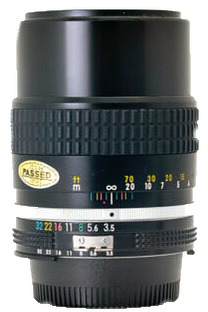 The
135mm f/3.5 Nikkor AI-S is a manual focus prime lens made
from 1977 to 1981 and has minimal distortion, excellent optics and a built-in lens hood. Only 81mm long,
it
takes 52mm filters. It's very portable - and very affordable - when compared to modern offerings.
If we
shoot stationary subjects and use a tripod or high shutter speed we rarely need autofocus or image
stabilization... especially at 1/20 the price !
The
135mm f/3.5 Nikkor AI-S is a manual focus prime lens made
from 1977 to 1981 and has minimal distortion, excellent optics and a built-in lens hood. Only 81mm long,
it
takes 52mm filters. It's very portable - and very affordable - when compared to modern offerings.
If we
shoot stationary subjects and use a tripod or high shutter speed we rarely need autofocus or image
stabilization... especially at 1/20 the price !
Photographer and lens-tester Christopher Perez writes "I think the Nikon Nikkor 135mm f/3.5 AI-S should become my 135mm "control" lens. It is the standard by which I could measure all other 135mm lenses."
For a collection of images made with the 135mm f3.5 Nikkor AI-S, click here.
 The
135mm f/4.5 Leitz Hektor is a manual focus prime lens made by Leica
from 1933 to 1960 in the classic 39mm Leica Thread Mount (LTM). This vintage lens has excellent blur rendition, likely due to its simple optical formula and very round 15-bladed aperture.
The
135mm f/4.5 Leitz Hektor is a manual focus prime lens made by Leica
from 1933 to 1960 in the classic 39mm Leica Thread Mount (LTM). This vintage lens has excellent blur rendition, likely due to its simple optical formula and very round 15-bladed aperture.
Ken Rockwell has done a fine job describing this lens: see his article here. For a collection of images made with the 135mm f4.5 Leitz Hektor, click here.
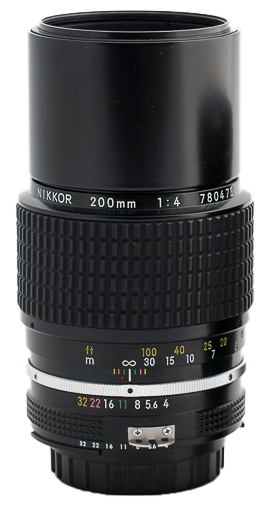 Like
the 135mm f/3.5, the
200mm f/4 Nikkor AI-S is a manual focus prime lens
with
minimal distortion and excellent optics. It was built from 1981 to 1996 and has a built-in telescoping
lens
hood. I love telescoping lens hoods !
Like
the 135mm f/3.5, the
200mm f/4 Nikkor AI-S is a manual focus prime lens
with
minimal distortion and excellent optics. It was built from 1981 to 1996 and has a built-in telescoping
lens
hood. I love telescoping lens hoods !
Keep in mind that a 200mm lens at f/4 has the same blur rendition and shallow depth of field as a 100mm lens at f/2 - or a 50mm lens at f/1.
Because it opens to a maximum aperture of f/4 it can take standard 52mm filters and is a very portable and affordable alternative to modern offerings. In situations of high local contrast, it can exhibit some color fringing but that is easily corrected.
For a collection of images made with the 200mm f/4 Nikkor AI-S, click here.
The 35-105mm Zoom Nikkor Macro was introduced in 1983 and is available at modest price in the used market. A manual focus zoom, it opens no wider than f/3.5 so it's compact, taking 52mm filters like the 55mm Micro Nikkor and many other Nikkor designs.
At 105mm this lens has extremely neutral blur rendition and is quite sharp at all distances. It can be used in place of a 105mm prime lens.
On a full-frame sensor, stopping down to f/8 or greater improves corner performance considerably. Click here twice for a full-size sample image shot at 105mm: 4x6 feet on typical web browser.
At widest apertures, if we're looking for the highest corner resolution this lens is better suited to APS-C format or close focus, where we use only the central portion of the image circle.
This lens has 16 elements in 12 groups and a ring which shifts the internal arrangement, allowing you to gradually transition to macro mode. At the 35mm setting, it can focus down to a 1:4 ratio. If we add a short extension tube the lens will focus very closely at all focal lengths.
For a collection of images made with the 35-105mm Zoom Nikkor Macro, click here.
 The
75-150mm Nikkor E f/3.5 was introduced in 1980. It's a
lightweight, manual-focus zoom. I inherited my copy from my father, who used it on his Nikon film camera
back in the day.
The
75-150mm Nikkor E f/3.5 was introduced in 1980. It's a
lightweight, manual-focus zoom. I inherited my copy from my father, who used it on his Nikon film camera
back in the day.
The "trombone" push-pull design provides a single ring to adjust both focus and focal length. This lens takes 52mm filters, has 12 elements in 4 groups and is quite sharp once stopped down. Most important, it has very neutral blur rendition which makes it a wonderful choice for portraits and close work.
This lens is featured on NIKKOR - The Thousand and One Nights No.42.
For a collection of images made with the 75-150mm Nikkor E, click here.
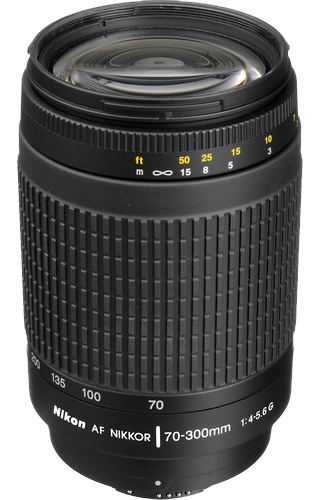 The
70-300mm Nikkor AF ED is very affordable and portable compared
to
similar offerings. This model provides autofocus on Nikon cameras, but no image stabilization. I use a
simple Fotodiox Nikon-to-Sony adapter which does not provide autofocus.
The
70-300mm Nikkor AF ED is very affordable and portable compared
to
similar offerings. This model provides autofocus on Nikon cameras, but no image stabilization. I use a
simple Fotodiox Nikon-to-Sony adapter which does not provide autofocus.
Stopping down to f/8 or greater improves corner performance considerably. At widest apertures, if we're looking for the highest corner resolution this lens is better suited to APS-C format or close focus, where we use only the central portion of the image circle.
To get higher resolution or built-in image stabilization, professionals who make very large prints may require a better lens - at much higher cost - but if we shoot at best aperture, print at reasonable size and avoid the corners of the sensor, this lens offers long reach and light weight at an attractive price-point.
For a collection of images made with the 70-300mm Nikkor AF ED, click here.
